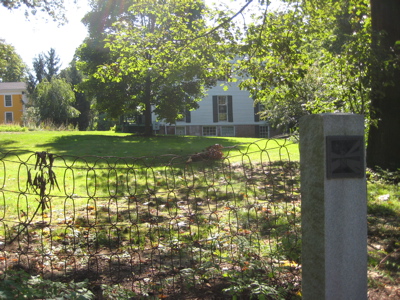Austin F. Williams House and Carriage House
CT National Historic Landmark
127 Main St. in Farmington (Private Residence)
The Austin F. Williams House is also on the Amistad Trail
Austin Williams (1805-1885) and his wife Jennet Cowles Williams were abolitionists. Their property first became important in the Amistad case. During the Mende’s imprisonment, Williams corresponded with his friend Lewis Tappan, a member of the Amistad Committee that had been established for the defense of the Amistad captives and was raising funds for their return home. Williams, Samuel Deming and John Treadwell Norton arranged for the Africans to be sheltered in Farmington after their release. Upon their arrival, the men and the one young boy, Kale, were housed on the second floor of Samuel Deming’s store. More room was needed, and Williams offered to build a temporary living quarters for them.

Sure my picture stinks, but at least you know it’s my picture. Note: The stone post in the foreground is the Freedom Trail Marker.
The dormitory was erected in a communal barn raising on May 4, 1841, and served as the primary home for the African men during the rest of their stay in Farmington. This building is today the east section of the carriage house–the west section was added on after the Mende had returned to their homeland. The men worked in local agricultural fields during their stay.
Shortly after the Mende left, Williams built his own house slightly to the southeast and converted the dormitory to a carriage house, which remained in the Williams family until 1948. Oral tradition indicates that Williams was an Underground Railroad conductor and, along with other citizens, made the Farmington community a major Underground Railroad stop. After the Civil War, Williams was appointed director of the Freedman’s Bureau of New England and New York and found housing and job opportunities for freed African Americans.
![]()
CTMQ visits CT’s National Historic Landmarks
CTMQ’s CT National Designations
Other Farmington Amistad sites

Leave a Reply